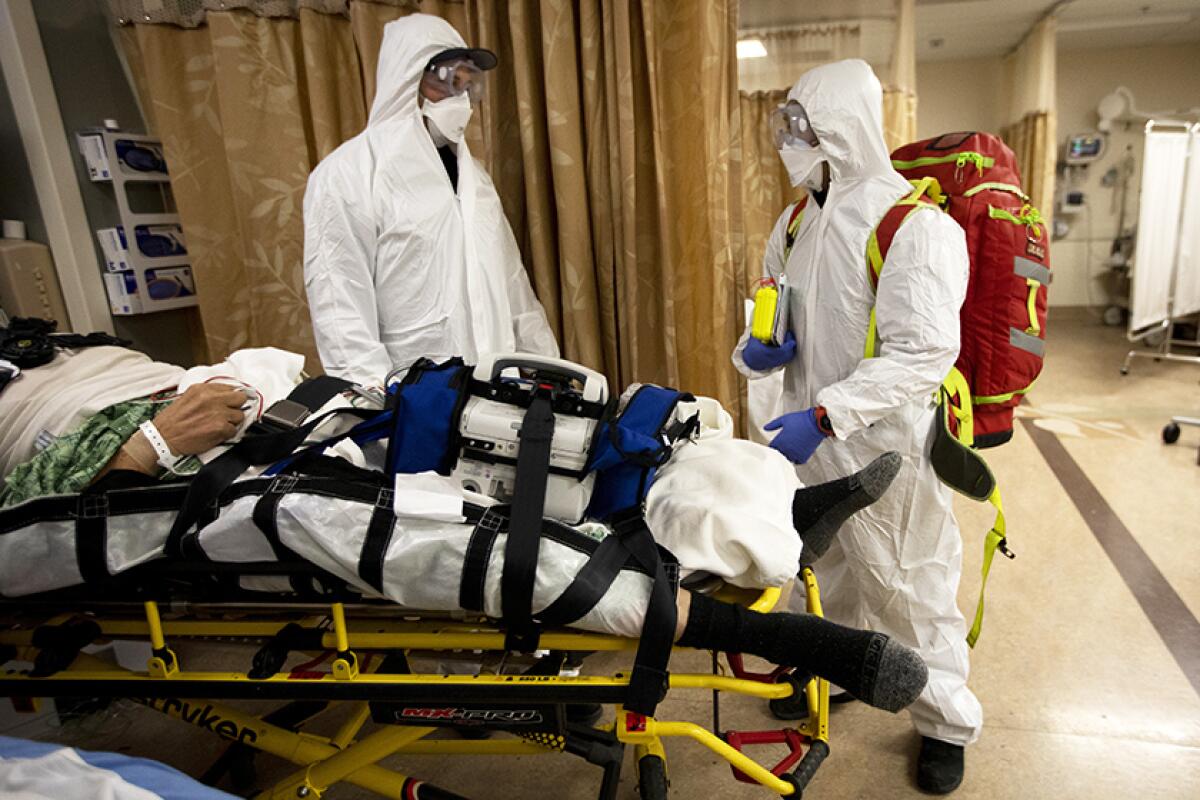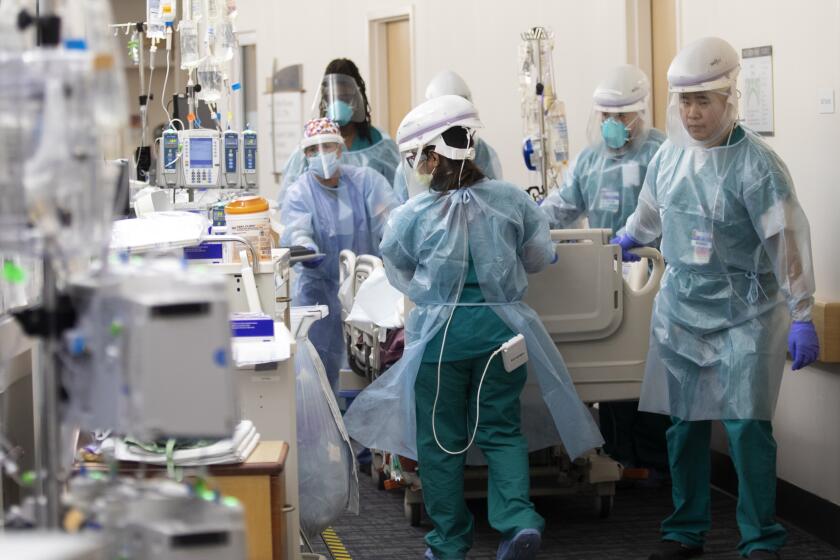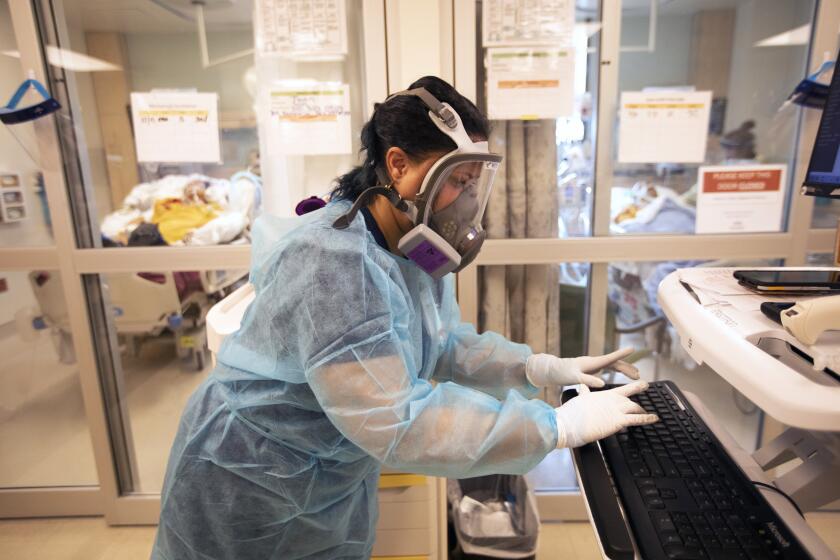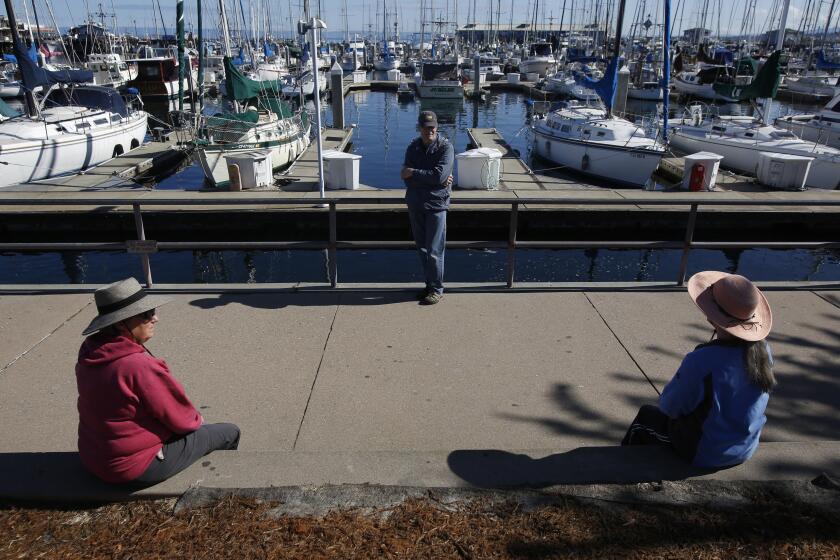December is a COVID-19 disaster in California. January is shaping up to be bleak too for deluged hospitals

- Share via
December has been the worst month of the COVID-19 pandemic in California.
But January is expected to be grim as well.
Officials are bracing for more COVID-19 hospitalizations as people who participated in holiday gatherings or travel and became infected with the coronavirus begin falling ill.
Dr. Robert Kim-Farley, a medical epidemiologist and infectious disease expert at the UCLA Fielding School of Public Health, said a person who was exposed to the virus at a Christmas gathering could be infectious by New Year’s Eve. But that individual may be asymptomatic, go to a New Year’s Eve party and unknowingly spread the disease, he said.
Coupled with a high infection rate — about 1 in 95 in Los Angeles County are contagious with the virus, according to county estimates — the holidays are creating a “viral wildfire,” Kim-Farley said.
Health officials urged those who traveled over the holidays to quarantine for 10 days to determine whether they develop signs of the illness.
“It’s a really big disaster if people come back and then just go straight back to work,” L.A. County Public Health Director Barbara Ferrer said Thursday.
L.A. was far more vulnerable to an extreme crisis from the coronavirus than nearly anywhere else in the nation.
What will January look like?
Officials are not sure how bad the post-Christmas surge will be.
Dr. Scott Gottlieb, who served as head of the U.S. Food and Drug Administration in the Trump administration until 2019, said on CBS News on Sunday that January would largely be a “grim month.”
“Even if we start to see a plateau in cases and a decline in the first week in January, it’s really not going to be [until] toward the end of January that we start to see the burden on hospitals begin to lessen and we start to see deaths plateau,” Gottlieb said on “Face the Nation.”
“Right now, the cases are being led by the coasts: California, Massachusetts, New York, New Jersey to some extent. When you look at the Midwest, when you look at the Great Lakes region, Illinois, Michigan, you’re starting to see cases come down quite discernibly,” Gottlieb said.
Dr. Anthony Fauci, the U.S. government’s top infectious diseases expert, said Sunday on CNN that the worst is yet to come, believing that a surge related to Christmas and New Year’s gatherings will, in fact, materialize.
“When you’re dealing with a baseline of 200,000 new cases a day and about 2,000 deaths per day — with the hospitalizations are over 120,000 — we’re really at a very critical point,” Fauci said.
The increase in the number of coronavirus cases will likely result in an extended stay-at-home order for Southern California and other areas.
Are there any promising signs?
Of course, the vaccine should dramatically improve conditions — but not in the short term.
California recorded what may be the start of a flattening of new cases just before Christmas; the average number of daily coronavirus cases over the prior seven days peaked Tuesday at about 45,000 a day before falling to 42,000 a day on Thursday, the day before many counties stopped reporting daily tallies in part because of the holiday weekend.
L.A. County averaged nearly 15,000 new coronavirus cases a day over the weekly period that ended Tuesday; as of Sunday night, the average was about 14,000 cases a day. It remains to be seen whether this is a flattening of new cases or the result of reporting delays amid the holiday.
But even if L.A. County is leveling off, health officials warn that the high number of cases is placing hospitals at a greater risk for overcrowding and a higher chance for poorer quality of care.
“If we’ve leveled off, we’re leveling off between 14,000 and 15,000 cases a day, which is way too high for us to take any solace in those numbers,” Ferrer said Wednesday. “We’d have to level off at a much lower rate for us to protect our hospitals.”
The COVID-19 patients who are in the hospital now reflect coronavirus cases diagnosed two weeks earlier — a time at which L.A. County was averaging 11,000 new cases a day. That means hospitals are still expected to see increasing demand into the new year because of infections that took place in early December.
And the current infections don’t take into account the expected surge in virus transmission over Christmas as a result of travel. If there was even half as much virus transmission as occurred over Thanksgiving, “we’re in deep trouble,” Ferrer said. A Christmas surge would be the third since the beginning of November, which would lead L.A. County to an “exponential growth in cases.”
A surge linked to Christmas and New Year’s celebrations could further strain and overwhelm hospitals, L.A. County Health Services Director Dr. Christina Ghaly said last week.
“Given the very, very high rate of hospitalization that we’re already at — where hospitals are already strained and overwhelmed — it is a situation that could easily become catastrophic in January if we have this surge upon a surge,” Ghaly said. That’s why it’s so important that people stay home for the holidays and not physically interact with people outside their household, she said.
World events influence language, and words once reserved for science or academia — think “social distancing” and “pandemic” — are used all over.
What are the conditions in hospitals?
The daily net increase in the number of people with COVID-19 in California’s intensive care units continues to rise, although the pace has slowed modestly. For the seven-day period that ended Saturday, a net average of 73 new ICU patients was added to ICUs statewide daily; the comparable number a week earlier was 113.
In L.A. County, the number of COVID-19 patients in the ICU increased by about 19% in the last week; the comparable figure the week before was 33%. Orange County also saw similar trends.
The moderating pace of net increases in ICU patients is welcome and likely a sign that the three-week-old stay-at-home order in effect across most of California is starting to work.
But it means ICUs are still being filled more than ever, at a time when many across California are over capacity, with critically ill patients stuck in emergency rooms when they should be placed elsewhere in the hospital.
ICU availability across Southern California and the San Joaquin Valley remains at 0%, and hospital systems have begun to circulate plans to ration patient care if demand far outstrips supplies or equipment. The risk of dying will go up dramatically if there are too many critically ill people in the hospital who cannot safely be accommodated by the limited supply of doctors, nurses and other medical staff.
Cumulatively, California has reported 2.13 million coronavirus cases and 24,288 deaths, according to an independent county-by-county tally conducted by The Times. The Golden State has been hit hard in the last two weeks, with more than half a million cases reported.
On a per capita basis, over the most recent two-week period, California ranks second for the most number of coronavirus cases reported per 100,000 residents, just below Tennessee.
Cumulatively, however, California ranks 34th among the 50 states for highest number of coronavirus cases per capita — likely a result of a relatively more successful implementation of the spring stay-at-home order and the closure of certain types of businesses in the summer that kept the first two waves of the pandemic far more under control.
But growing fatigue and widespread rejections of pleas to stay home have now resulted in California’s worst wave of the pandemic.
Already, in L.A. County, some ambulance patients are having to wait as long as eight hours before being allowed into the emergency room, and hospitals are running dangerously low on oxygen. Emergency rooms are so crowded that most hospitals have been forced to divert ambulances elsewhere for certain parts of the day.
State officials said Sunday that Southern California and several other areas would likely have to continue following the regional stay-at-home restrictions for several more weeks as the recent surge is pushing hospitals to the breaking point.
President Trump on Saturday took aim at California on Twitter, writing that “the lockdowns in Democrat run states are absolutely ruining the lives of so many people,” adding that “cases in California have risen despite the lockdown, yet Florida & others are open & doing well.”
Cumulatively, however, Florida has tallied a higher death toll on a per-capita basis than California, with 103 deaths per 100,000 Florida residents, while California has reported 62 deaths per 100,000 California residents. If California had the same death rate as Florida, its cumulative death toll would be about 40,000, instead of the 24,000 it is today.
Times staff writers Brittny Mejia and Dakota Smith contributed to this report.
More to Read
Sign up for Essential California
The most important California stories and recommendations in your inbox every morning.
You may occasionally receive promotional content from the Los Angeles Times.















